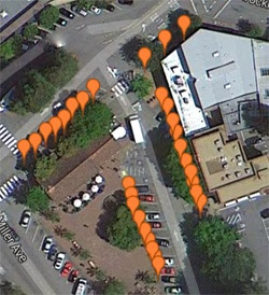The other day, we looked at a new apartment building proposed for downtown San Rafael with mindbogglingly expensive parking and tried to determine how the project could be improved. One big way that deserves a second look is allowing people to rent parking spots and apartments separately.
Thanks to city law, a developer is not allowed to unbundle the cost of those parking spaces from the rent it charges tenants. Tenants don’t get the choice of whether they get a parking space or not. They just do.
Unlike a single-family home, however, these garages aren’t adaptable. A tenant can’t just use their reserved 153 square feet (8’6” by 18’) for storage or as a workspace. Adaptation isn’t just impractical, but per the city code, it would be illegal. Instead, the parking space will just sit, an empty slab of concrete soaking up $700 per month in rent. That raises the income needed to rent a market-rate home by $25,200. This is fundamentally unfair, soaking money from tenants for a resource that may not be used, damaging the vitality of the city. It gets worse.
If I’m already paying for car storage, then it’s a strong incentive for me to get a car. The developer has already spent over $55,000; I might as well go the extra $5,000 and buy a car. That will incentivize me to do things like drive more, avoid transit, and otherwise help choke up the roads and air. It gets worse.
If I’m paying $700 per month for the required car storage and another $300 per month on car ownership (car payments, gas, maintenance), that’s $1,000 I won’t be able to spend around Marin, depressing my value as a resident. That’s $12,000 per year leaving the county rather than going to local business (gas and maintenance shops ship most of their income out of the local economy).
Not only does this law restrict personal freedom of choice, it drains away hundreds of thousands of dollars from the local economy each year, and that’s just on this project. If San Rafael’s empty parcels get a similar treatment, it will be millions. It encourages car ownership and traffic and wastes the money of people who might want to go car-free.
There are three, radically simple solutions.
Repeal the parking minimum requirements for all new development in San Rafael. Developers know that they need parking sometimes to sell or rent units, but the city shouldn't substitute the judgment of skilled businesspeople for the judgment of whoever wrote the parking codes long ago.
Allow developers to unbundle parking spaces from any rent or purchase. If someone wants to buy or rent a place to keep their car, they're welcome to it, but like most products it shouldn't be forced upon consumers.
Allow parking space owners or renters to use the space for other purposes, whether a storage unit or even a workshop. It's a lot of square feet, and the owner/renter is paying for it. They should have a right to do whatever they like with it.
Each of these may have some unintended consequences, which we'll discuss next week.

